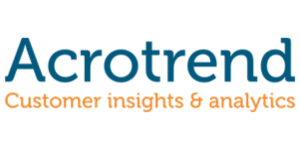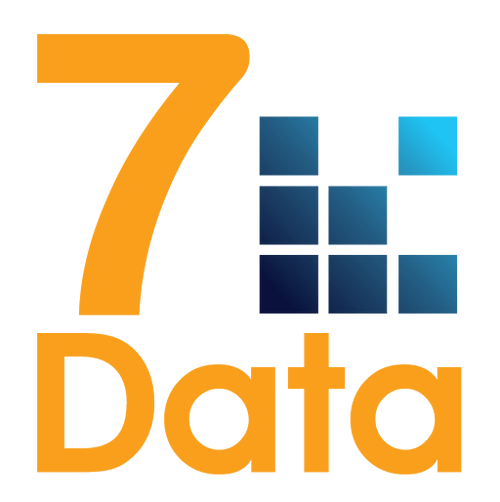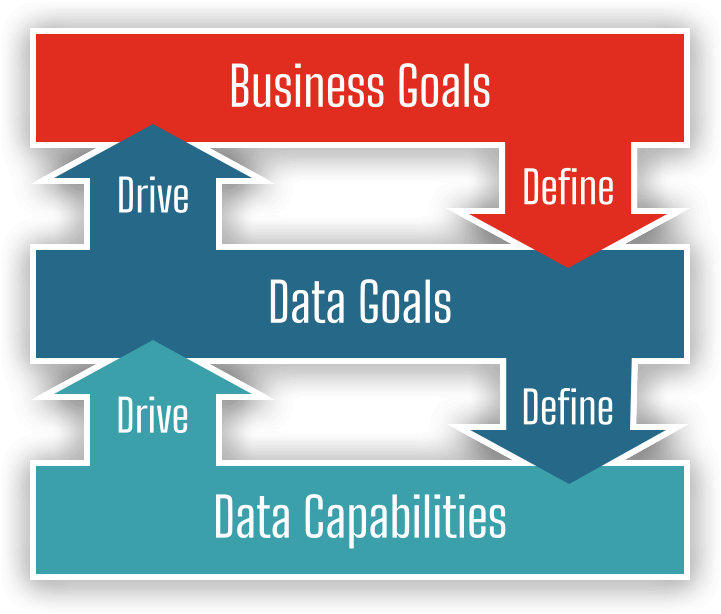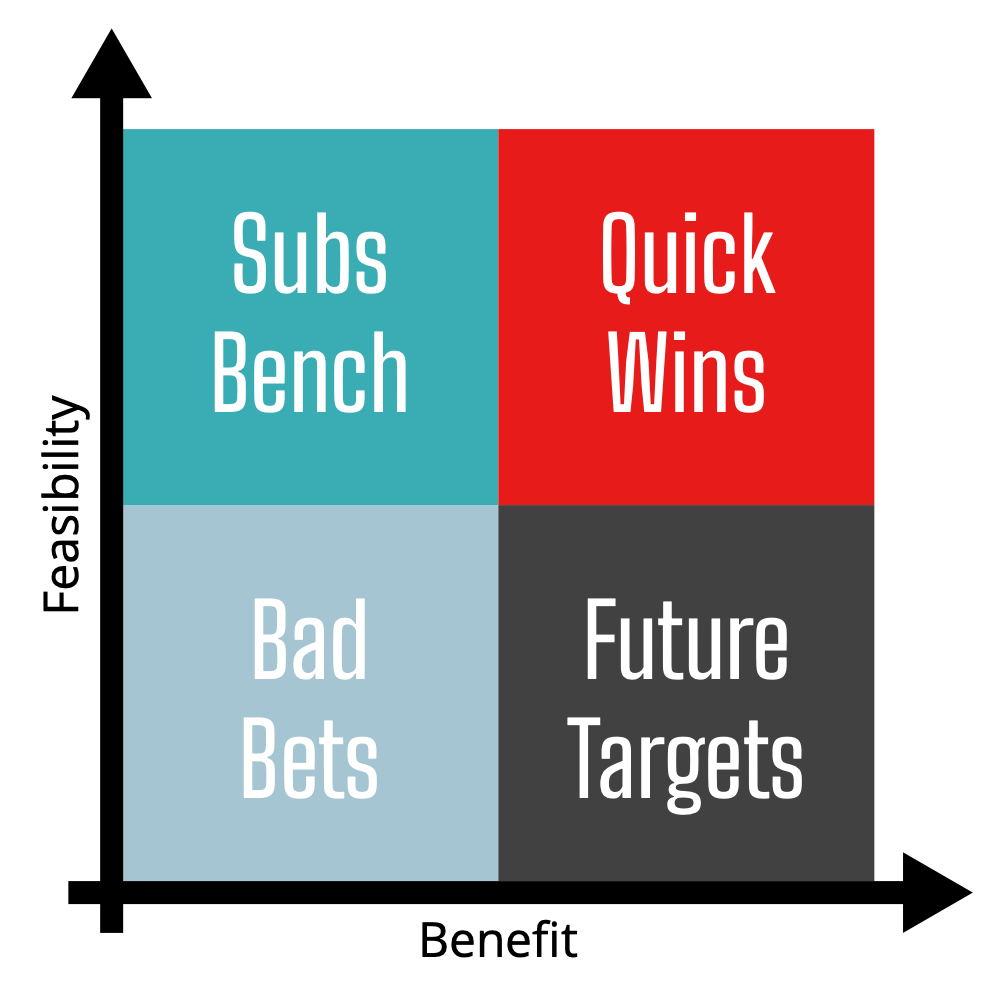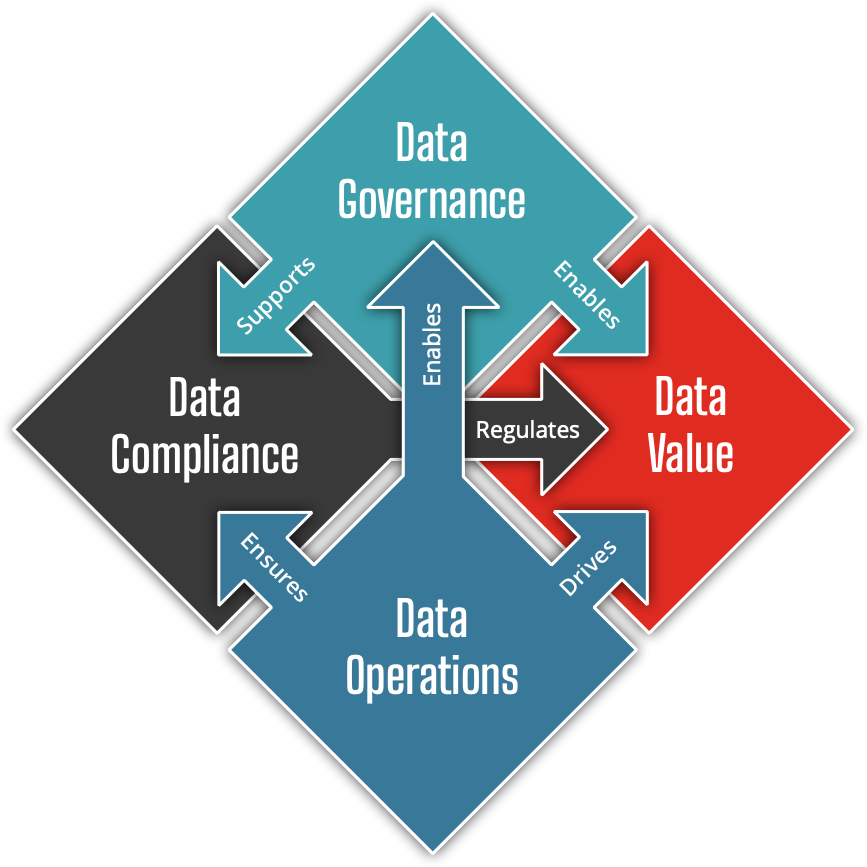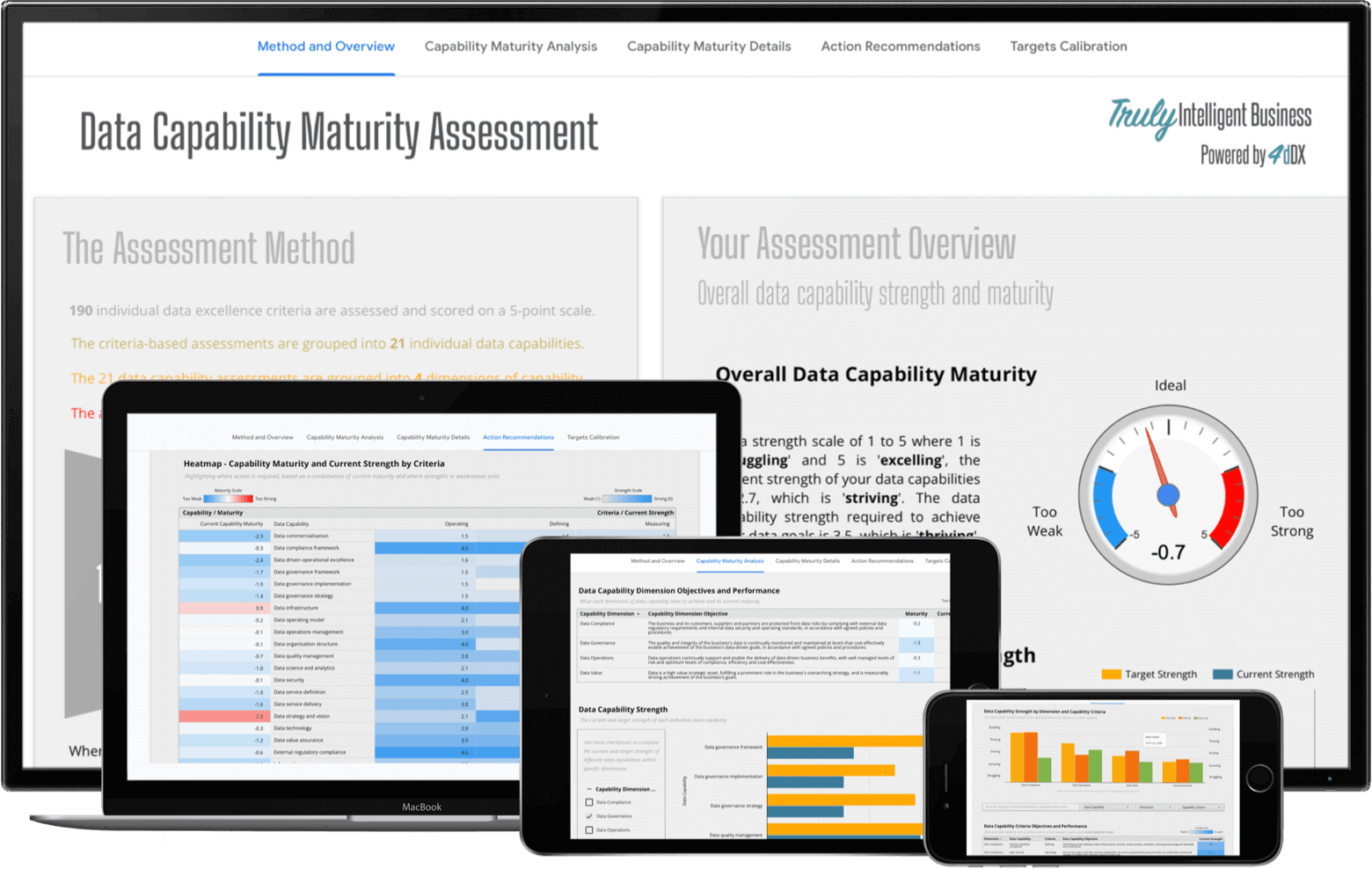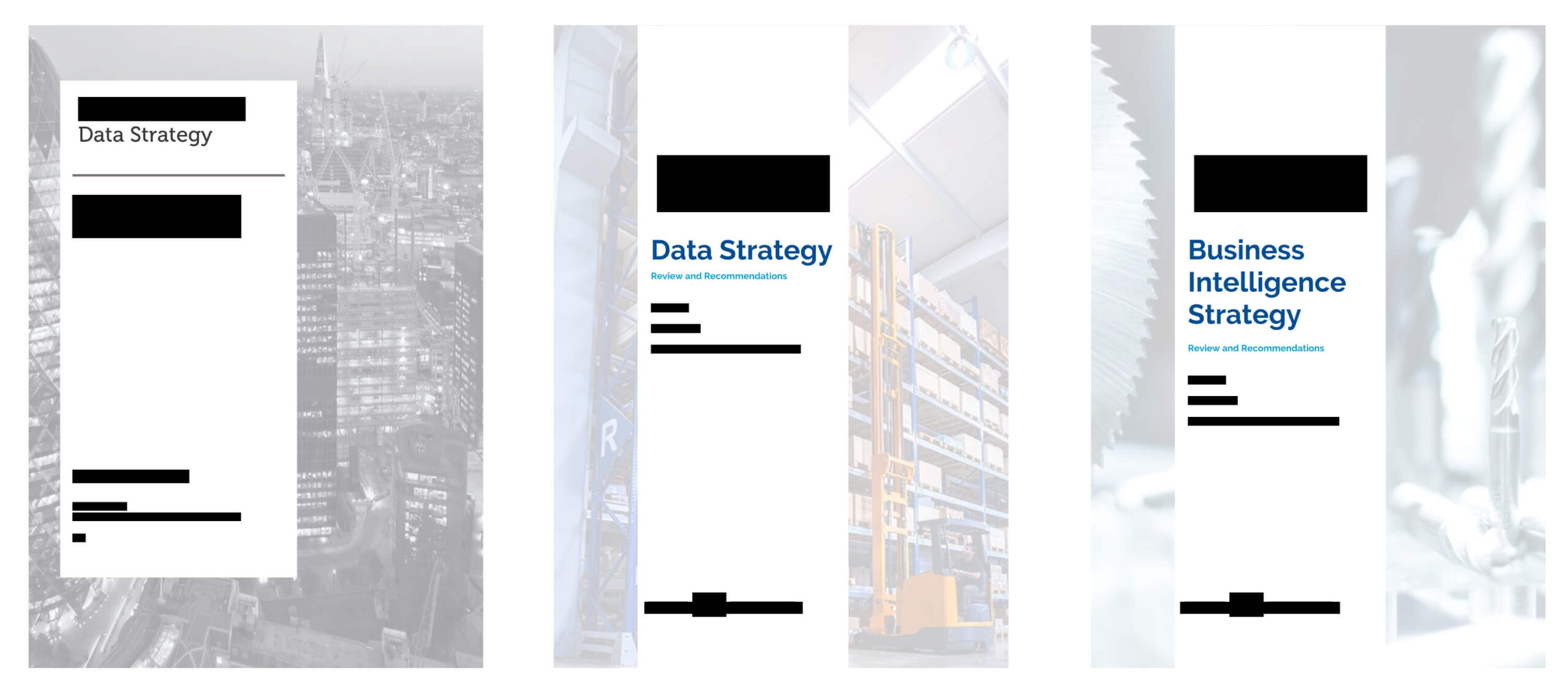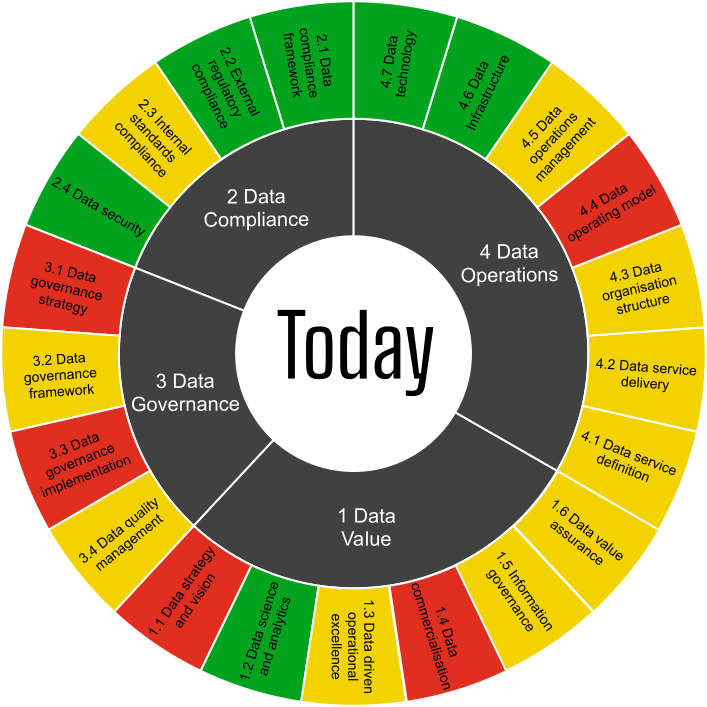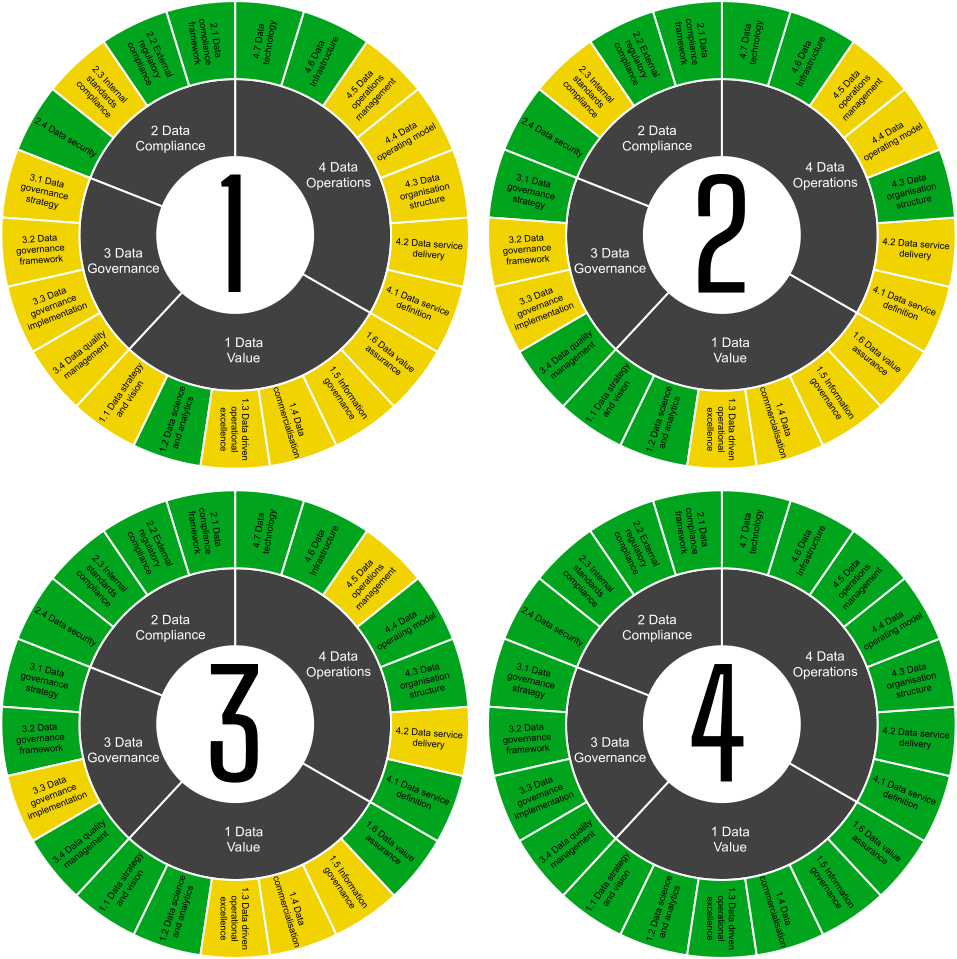A COMPLETE IN-DEPTH GUIDE
How to create and implement an effective data strategy
One that makes you data-driven, not data-busy.
What you’ll find in this how-to guide
This comprehensive guide will tell you how to build a data strategy which is aligned to your business’s goals, simple enough to understand, and detailed enough to implement.
In the following sections, you’ll find answers to all of the ‘why’, ‘how’, and ‘what’ questions – to help you rapidly create a winning data strategy.
- The Why’s – Core principles which explain why data strategy is important, and key concepts which explain why the approach in this guide is the right one.
- The How’s – Step-by-step instructions on how to craft a data strategy that people will read, understand, support, and implement.
- The What’s – Links to resources that you’ll find useful, and sources of help for getting answers to questions and tapping into expertise.
Get your FREE data value accelerator toolkit
If you’re striving to eliminate data headaches and achieve data goals, but struggling to work out how with limited budget and resources – tell us what your current data challenge is and we’ll give you real examples, techniques, and templates that will get you moving.
How this guide works
Part 1 – Define your data goals based on your business goals
- Step 1 – How to get the right people on board, by building awareness of how data goals will drive achievement of business goals.
- Step 2 – How to define the jobs your data need to do, by specifying how data will drive business processes to achieve your business’s goals.
- Step 3 – How to build data use cases, to define and prioritise the data work that needs to take place to achieve your data goals.
Part 2 – Translate your data goals into your data capabilities
- Step 4 – How to define what data capabilities your business needs, so that people know what your business needs to have and do with its data.
- Step 5 – How to analyse your data capability maturity, to pinpoint data capability gaps that could hold up progress and so will need to be closed.
- Step 6 – How to compile and present your data strategy, in ways that make sure people will read it, embrace it, and implement it.
Part 3 – Communicate and implement your data capabilities
- Step 7 – How to build momentum towards achieving data excellence, through effective communications which foster positive business engagement.
- Step 8 – How to close gaps in your data capability maturity, by implementing the right strategic data capability development roadmap.
- Step 9 – How to use data strategy to achieve your data goals, by iteratively developing data capabilities and realising data-driven objectives.
Why this guide exists and who it's for
The need for and importance of data driven strategy is growing, driven by a combination of the ever-increasing range of benefits that data presents to businesses, and the heightening awareness that data strategy is essential for achieving those data-driven benefits.
When it comes to being truly data-driven, having an effective data strategy is as essential as having sound data infrastructure, efficient data integration, and solid data skills. And yet data strategy still often feels mysterious to businesses. The role of data strategy in achieving data excellence is unclear to many business leaders, and the question of how to create an effective data strategy sits uncomfortably in the mind of many data professionals.
This guide exists to address both of those issues. If you’re a business leader, then the information here will help you to set the agenda for data excellence in a way that ensures other people come along for the ride. If you’re a data professional, then this guide will show you a way to quickly and reliably bring data to life in ways that achieve business goals. Finally, if you’re a student (or anyone else) you’ll find this guide will give you a holistic definition of what data excellence looks like and how it is achieved.
Introduction
Avoiding data-busy: Why data strategy is essential
Whether it’s through analytics, AI, machine learning, data science, or data commercialisation – more businesses than ever are aiming to harness the power of data, which means that those same businesses are embracing data strategy.
Why? Because like any strategy, a data strategy is essential for getting on (and staying on) the right track to achieve desired objectives. Whether your data objectives are analytics, automation, or AI – a data strategy is the crucial first step to becoming truly data-driven, and not ending up just data-busy.
What’s ‘data-busy’? It’s simply where data effort and investment is high, but data benefits are relatively low. It’s a trap that businesses easily fall into when they focus more on technology and data outputs, and focus less on strategy and data outcomes.
There’s three core principles of effective data strategy
- Principle 1: Data goals are defined by how data will drive achievement of the business’s goals.
- Principle 2: Data goals must be translated into the data capabilities required to achieve them.
- Principle 3: Data capabilities must be specified and communicated so that the business can acquire and operate them, in ways that drive data goals to achieve business goals.
How to build a data strategy: The recipe for success
To create and implement a data strategy that makes your business truly data-driven, you must embrace all of these principles. So let’s start by understanding what each of these three principles means in practice.
- Principle 1: Data goals are defined by how data will drive achievement of the business’s goals.
This is the very definition of ‘data-driven’. Fundamentally, the thing you want data to drive is the achievement of your business’s goals. So it’s crucial to start by defining goals for your data, based on how they will benefit your business. Because if you end up chasing data goals that don’t benefit your business’s goals, then you’ll find yourself wasting time, effort and money on moving in the wrong direction.
- Principle 2: Data goals must be translated into the data capabilities required to achieve them.
We know that data goals aren’t achieved by magic! They require the right mix of people, processes and technology which we collectively refer to as data capabilities. Data capabilities are ‘where the rubber meets the road’. Without sufficient data capabilities, your business will simply spin its wheels and fail to move towards achieving its data goals. And before you can acquire the right data capabilities, you of course need to know what they are.
- Principle 3: Data capabilities must be specified and communicated so that the business can acquire and operate them, in ways that drive data goals to achieve business goals.
When you define data capabilities, you need to do it in ways which mean they can be implemented and not just theorised. That means you need to keep it simple enough for people to understand, but also detailed enough for people to build and adopt. If people can’t understand what needs to happen, then it’s impossible for them to do it. And if it’s unclear how your data capabilities will work, then it’s impossible for people to apply them in the right ways to achieve your business’s goals.
The model for building data strategy that makes you truly data-driven
Being truly data-driven, means having the right capabilities for using data in ways that drive achievement of your business’s goals.
Read on to discover how to create a data strategy that will enable your business to accomplish this…
Why this is the right approach to data strategy
There’s a variety of opinions on how to create an effective data strategy, and multiple options for methods of doing it. So what makes the approach in this guide the right one?
There are four primary reasons why the approach described in this guide creates data strategies which don’t just sit on a shelf, and are ‘real-world’ effective in making businesses truly data-driven.
- This approach maximises data strategy RoI.
Because it’s rooted in a focus on business goals, this approach to data strategy ensures that the actions and changes that it triggers, are ones that drive your business in the right direction to achieve its goals and deliver high data value.
- This approach creates a data strategy which attracts support and investment.
Because this approach creates a data strategy which is simple for people to understand, it will be supported and funded by your business’s leadership, and embraced by the people who must deliver it.
- This approach creates a data strategy that can be robustly implemented.
Because this approach creates a data strategy which specifies data capabilities in rich detail, people will believe it can be implemented rather than seeing it as just wishful thinking. And that same detail makes implementation of the data strategy both realistic, measurable, and effective.
- This approach assures long-term positive business change and value.
Because this approach creates a data strategy in a logical and formulaic way, it can be easily and inexpensively tracked and evolved. That means progress in implementing the strategy can be measured over time, and your business can stay on course instead of continually reconfiguring how to respond to changing business needs and priorities.
Discover how to build your own fully tailored data strategy in as little as one month!
Part 1 – Define your data goals based on your business goals
This first part focuses on principle number one, by defining how data will drive achievement of your business’s goals.
Step 1 - Get the right people on board
The first essential step in defining your data goals, is to connect with the people who are accountable for your business’s goals. You’ll need to work with your business’s leadership team to not only get the most up-to-date and accurate picture of your business’s goals, but to also get them on board with the data strategy process.
It’s vital that the people who set your business’s goals, also understand what your data goals are – and agree that achieving those data goals is necessary to drive achievement of your business’s goals.
When people can see and understand how data will help them to deliver the business goals they are accountable for – then they will enthusiastically support the data goals, and the steps necessary to achieve them.
By illustrating to people not just how data can benefit the business, but also how data can help them to benefit the business, those people will more willingly and enthusiastically support the data strategy, and the subsequent work to achieve data goals.
By bringing personal and organisational views together, you’ll ensure that stakeholder sponsorship is founded on the right reasons. It’s one thing to garner leadership support based on ambitions and political manoeuvring – and another thing altogether to build that support on an accountable and realistic vision for how data will benefit the overall business.
Now that you’ve got the right people on-board, in the right way, for the right reasons – you can move onto step 2.
Make data success, someone’s success
The best way to secure stakeholder support right from the start, is by talking to people about the ways that data can help them to achieve the goals that they are accountable for.
Step 2 - Define the jobs your data need to do
For this next step, you must put data strategy aside for a moment and instead focus on business processes, because they are the links that will tell you how your business’s goals translate into your data goals. The right technique is to answer these three key questions:
- What overarching goals is our business aiming to achieve?
- What must our business do to achieve those goals?
- How can data help our business to do those things and achieve those goals?
The overall question you’re seeking to answer is ‘how can data help the business to do what it must do, so that the business can be what it aims to be?’ You must identify the high-level groups of processes which work to achieve your business’s goals, because it’s those processes which are the targets for your data goals.
For an example, let’s take a basic look at the common business goal of ‘increase customer lifetime value’. To achieve that goal, a business needs to fundamentally do two things – extend customer lifetime and increase customer value. So the kinds of processes involved in that are things like customer support (to keep customers happy) and pricing and promotions (to get them spending more).
| Business Goal | High-Level Business Process |
| Increase customer lifetime value. | Support customers’ needs so that they are happy and loyal. |
| Price our products so that our customers buy more of them. |
Sometimes, you may find that it’s not entirely clear what or how processes work to achieve a certain goal. But that’s also something that you’re absolutely looking for. You want to find out where there are gaps in your business’s processes. Because it doesn’t matter how much data you push into those areas, if the business processes themselves are underdeveloped or missing, then no amount of data will fix that. Failing to see such gaps in your process infrastructure, could easily lead to a situation where it’s incorrectly believed that the data is failing to do its job, when in fact it’s the underlying processes that are at fault. That’s a situation which will make you data busy.
Now that you’ve clarified what your business must do to achieve its goals, it’s time to define how data can help you to achieve those goals. This can often pose an interesting challenge, and the fact that the answer to that fundamental question isn’t always clear, is a common reason why businesses which ignore data strategy often end up highly data-busy, as they unwittingly invest time and money in building data solutions to undefined business challenges. Your aim is to define meaningful and valuable jobs for your data to do, not create solutions looking for problems.
Consider each business process, and try to pinpoint data outcomes in each of these three categories of data value. Naturally, insights and analytics is the most common form of data value. And it’s worth pointing out that at this early stage you’re only envisioning data value. Before you take any steps towards achieving that value, you must ensure absolute compliance with data regulations. We’ll come to that in step 2.
Let’s expand on the previous example. Your business’s goal is to increase customer lifetime value, so the processes involved are customer support and pricing and promotions. The data goals in this scenario would be insights and analytics which help you to retain customers for longer, and encourage them to buy more.
| Business Goal | Business Process | Data Goal | Data-Driven Outcome |
| Increase customer lifetime value. | Support customers’ needs so that they are happy and loyal. | Analyse why customers leave, so we can prevent that. | We can minimise customer lapses and maximise customer retention and loyalty. |
| Analyse why customers stay, so we can assure that. | |||
| Price our products so that our customers buy more of them. | Analyse pricing and promotion revenue performance. | We can pinpoint which pricing strategies work best to maximise long-term revenue. |
This is of course only a generalised example. There are other closely related business goals such as profitability, which you would want to analyse as well.
In almost all cases, getting data to do jobs that benefit your business starts with knowing what your business has to do, how, and why. Getting the answers to those questions is a matter of looking at how your business needs to work to achieve its goals, and then defining how data can help that to happen.
It’s worth pointing out that there is a possible exception to this, where fully autonomous AI applications use data not to drive a process, but to define if a process is necessary and what the process should be. In such cases, the jobs that data needs to do are ‘be available’, ‘be accurate’ and ‘be appropriate’, so that the AI can determine the need for an action, define the right action, and execute the action.
To rapidly translate business goals into data goals, unlock access to the free Data Strategy Management Toolkit, where you’ll find a variety of useful templates and information.
How to pinpoint data value
If you’re finding it hard to translate business processes into data goals, then you’ll find it useful to know that there are only three ways that any business derives value from data.
- Learn from data, through insights and analytics
- Work better through data, through automation and AI.
- Generate revenue from data, by selling data and data products.
Step 3 - Build your data use cases
Now that you’ve defined how data can help your business to achieve its goals, the next step is to define how that will happen. This means you need to answer two key questions:
- How feasibly can we achieve each data goal?
- How urgently must we achieve each data goal?
To answer these questions, you’ll need to start layering some details onto the data goals that you defined in step 2. For each data goal, the questions you need to answer are:
- What situation, requirements, challenges or opportunities does the business see?
- What overall objectives is the business aiming to achieve?
- What jobs do data need to do, to ensure the objectives are achieved?
- What high-level data activities do we expect will be necessary to achieve the objectives?
- Who needs to be involved and in what way?
- How will we prove that this data use case has been successfully fulfilled?
- How will work to fulfil this data use case be performed and managed?
As you’re now starting to gather more information about your data goals, you’ll need to record each of them as a data use case which you can communicate and version-control. Each of your data use cases will be a documented definition of a data goal and the work necessary to achieve it. You’ll use the information in each data use case to perform high-level feasibility and needs analysis.
By progressively documenting data use cases, you’ll compile a backlog of the potential work required to achieve your data goals. This gives you the essential clarity you’ll need to translate your data goals into the data capabilities required to achieve them, as well as gathering the information you’ll need for building business cases for data capability development later in step 7.
If you don’t have a backlog of data use cases, it’s almost impossible to accurately determine how you’ll use data to drive achievement of your business’s goals. If you tried to build a data strategy without data use cases, then you’d effectively be creating a strategy based on guess-work and assumptions, which is the poorest foundation for any strategy!
In summary, the purpose of creating data use cases is to:
- Document a real-world view on data goals, so that your data strategy will not be merely conceptual, and will instead be wholly realistic.
- Maintain positive stakeholder engagement by showing focus on the topics that matter to them.
- Create a foundation of information that will enable people to understand and engage with your data strategy.
- Record an initial understanding of how data goals may be achieved, so that this understanding can evolve as your data strategy is developed.
- Capture people’s opinions and expectations, so that they can be tested in the following steps.
- Record information that will be used to build future business cases for investment in data capability development.
How to target low hanging data fruit
As you build a backlog of data use cases, make sure that each one has a clear business sponsor from the cohort of data strategy stakeholders that you convened in step 1. Then prioritise them by ranking their feasibility and urgency, and plotting them on a chart like this. This high-level and preliminary prioritisation will be refined and honed later in step 6.
To make it quicker and easier to document your data use cases, you’ll find a tried-and-tested data use case template in the Data Strategy Accelerator.
- Subs bench– The data use case is feasible as the gap between current and target state could be closed with some appropriate development, but the data use case itself is currently not that beneficial to the business.
- Quick wins– The data use case is feasible as the gap between current and target state can be closed with some appropriate development, and the data use case itself will deliver immediate benefit to the business.
- Bad bets– The data use case is not feasible as there is a large gap between current and target state which will not readily be closed, and the data use case doesn’t stand to benefit the business enough to be worth the investment to close the capability gap.
- Future targets– The data use case is currently not feasible as there is a large gap between current and target state which will not readily be closed, but the potential benefit of implementing this data use case is high and therefore warrants future investment to close the capability gap.
Part 2 – Translate your data goals into your data capabilities
Now that you have a backlog of data use cases, you’ve compiled the essential information and understanding which is necessary to start defining what levels of data capability are required to achieve your data goals.
This second part now focuses on principle number two, by translating your data goals into the data capabilities required to achieve them.
Four dimensions of data capability
Remember that data capabilities are ‘where the rubber meets the road’. Your data strategy needs to translate your data goals that state what needs to be achieved, into the data capabilities which state how to achieve them.
Also remember that when defining data capabilities, it’s important that your data strategy is both simple enough for people to understand, and detailed enough to implement. At this stage it’s easy to either get sucked into depths of detail that will make your data strategy too big and cumbersome, or conversely to be so vague and conceptual that your data strategy fails to gain traction.
To strike the perfect balance between simple and comprehensive, all you need to do is recognise that all data capabilities fall into one of only four dimensions.
The four dimensions of data capability are:
- Data Value. The capability to maximise data benefits and support achievement of business goals, by promoting and facilitating data science and analytics, data driven operational efficiency and data commercialisation.
- Data Compliance. The capability to ensure your data are safe to own and use, by managing exposure to data risks through maintaining sufficient compliance with applicable data security and privacy regulations.
- Data Governance. The capability to optimise the performance of your data, by setting appropriate data quality standards and regulating data behaviours to uphold those standards.
- Data Operations. The capability to optimise data operations, by providing systems and services that fulfil your organisation’s data needs whilst minimising costs and complexity.
By summarising data capabilities at this simple level, whilst also specifying data capabilities in greater detail later on, you can create a data strategy that speaks to all stakeholders at all levels.
The 4dDX data strategy framework
The four dimensions of data capability sit at the heart of a data strategy framework called ‘Four Dimensional Data Excellence’ or 4dDX, for short.
The 4dDX framework was developed to make it easy for businesses to create compelling data strategies, and rapidly acquire the right data capabilities.
Online access to and non-commercial use of 4dDX is completely free. Just visit https://4dDX.app to open the entire framework in Miro.
4dDX works by defining a range of 21 data capabilities which are grouped into the four dimensions, making them simple to communicate and easy to understand. At the same time, 4dDX also contains 338 individual data capability success criteria, which precisely specify how each data capability is defined, operated and measured.
Of course, you don’t have to use 4dDX to create a data strategy. But because 4dDX was created specifically to enable the method described in this guide, it will be referenced in many of the remaining steps.
Step 4 - Define the right data capabilities
Your objective in this step is to formulate a range of data capabilities which are relevant to the fulfilment of your data use cases, and are specified in enough detail for stakeholders to understand what your business needs to have or do.
How to translate data goals into data capabilities
Translating your data goals into the data capabilities required to achieve them, is just a matter of answering two simple questions:
- What do you need to do?
- How good do you need to be at it?
As straightforward as those questions may seem, their answers undoubtedly create the very core of your data strategy. Metaphorically, if your data vision that was defined in step 2 is the equivalent of an artist’s impression of a new building, then the answers to those questions are the equivalent of the structural engineering blueprint for how it will be built.
Let’s therefore expand on those two questions a little, and think about them in terms of:
- What skills and technologies do you need to have?
- How proficiently and extensively do you need to apply them?
Conveyed in this way, you can start to see what data capabilities really represent. They are an expression of what your business needs to have or do. As well as how much of it you need, and how well you need to do it.
How to define the right data capabilities for your business
Every business is in some way unique, but many data needs and challenges are often common amongst different businesses. So whilst it’s important to understand what your specific business’s data capabilities need to be and why, it’s also important to not risk being data-busy by unnecessarily reimagining conventional data capabilities. There’s no point in trying to reinvent the wheel.
This is where 4dDX helps. By providing you with a pre-built framework of 21 data capabilities, 4dDX not only makes it faster and easier for you to create a data strategy, it also helps you to make sure that your business possesses all of the right data capabilities. The 4 dimensions of 4dDX represent elementary groups of data capabilities, which every business must possess in some form and to some degree.
To translate data use cases into the data capabilities required to fulfil them, your business must ask itself:
- Do we know what data value in this case means to our business, and how to achieve it?
- How will we fulfil our data compliance obligations in ways that protect our business and people from data risks?
- How will we apply data governance in ways that regulate data behaviours to attain and maintain sufficient data quality?
- How will we optimise our data operations to fulfil our business’s data needs whilst minimising costs and complexity?
To find the answers to each of these questions, review all of the 21 data capabilities in each corresponding dimension of the 4dDX framework, and make notes on how each data capability in 4dDX aligns to each of the data use cases that you compiled in step 3.
Don’t assume that the predefined data capabilities in 4dDX are completely right for your business as-is. Part of the power of 4dDX, is its flexibility to be adapted to different or unique situations. So when reviewing the data capabilities in 4dDX, make the following confirmations and considerations.
- Confirm that capabilities from all of the 4 dimensions are aligned to every data use case, to ensure that data value will be targeted safely and cost effectively with quality data.
- Consider excluding any capabilities that you think are unnecessary for fulfilling your business’s data use cases.
- Consider amending any capabilities which you think would be better aligned with your business’s data use cases, if they were defined differently.
A good example of undoubtedly the most common modification that businesses make to 4dDX, is the elimination of the data commercialisation capability. Here’s what that data capability looks like:
| Data Capability | Data Capability Description |
| 1.4 – Data Commercialisation | The business safely generates profitable revenue from its data by converting its data into marketable products or services whilst controlling commercial risks |
This data capability exists in the 4dDX framework, to recognise the fact that data commercialisation is definitely one way that some businesses strive to generate value from their data. But because it often carries significant data privacy and compliance risks, as well as large data technology and operations overheads, many businesses simply elect not to target data commercialisation value in their data strategies. Where this is the case, the correct approach would of course be to exclude this 4dDX data capability from your data strategy, for the simple reason that you do not have any data use cases to which it is relevant.
Another example of how to modify 4dDX data capabilities to suit your business’s needs, is honing data capability facets and criteria. This is performed when a data capability is relevant to one or more data use cases, but it is expressed in a way that isn’t fully aligned to the business’s data situation or needs.
For example, let’s look at the data capability of ‘Data Organisation Structure’, which is capability 4.5 in the 4dDX framework.
| Capability Description | Capability Lens | Capability Facet |
| There is a clear and agreed understanding of the personnel roles necessary, and those roles are occupied by appropriately skilled people, to provide the expertise and resource capacity necessary to fulfil data operations in ways that achieve the objectives defined in the business’s data strategy. | Defining | An appropriate data organisation structure is defined. |
| Operating | The data organisation structure is fully implemented. | |
| The people in the organisation structure always have the right skills and support to meet business data needs. | ||
| Measuring | The business’ needs for data skills, and the needs of the people in the organisation structure are constantly monitored for change |
All of this information is appropriate to a business that is hosting its own internal teams of data professionals, but it may not be entirely appropriate to a business that is outsourcing all of its data operations. However in that case and in the interests of simplicity, you could still choose to leave these facets unmodified. But let’s dig even deeper to look at the criteria behind one of those operating facets.
| Capability Lens | Capability Facet | Capability Criteria |
| Operating | The data organisation structure is fully implemented | There is a HR budget for data ensuring a constant source of sufficient funds to maintain required levels of skilled data personnel |
| All of the roles in the data organisation structure are populated with people who have the right skills and experience to fulfil each role | ||
| When a role in the data organisation structure becomes vacant, recruitment processes exist that can refill the role quickly and effectively | ||
| Data leadership provides the business’ HR team with support and expertise to help the HR department to understand the specialised nature of the data organisation structure |
At this maximum level of detail, we can see that these capability criteria are not entirely relevant to a business which is outsourcing all of its data operations. In that case whilst you could choose to leave the facet unchanged, you would undoubtedly want to revise these capability criteria to more accurately reflect the real needs of your business.
How to use 4dDX to define data capabilities
If you’d like to use 4dDX to define your data capabilities and power your data strategy, simply visit https://4dDX.app. That will open the complete 4dDX framework in Miro, where you’ll find a diagrammatic version of the framework, supplementary and supporting information, links to community based support and a user guide, and a spreadsheet version which you can download and modify the content of as much as you require.
One note of caution – whilst it is good practice to hone the content of 4dDX to suit your business, it’s important to not modify the layered structure of 4dDX. That’s because the power of 4dDX lies in its ability to translate a simple view of data capabilities into a complex one which contains a great deal of detail. Therefore the hierarchy of dimensions, facets, and criteria must be preserved in order for it to work.
Step 5 - Find gaps in your data capabilities which you’ll need to close
Your objective in this step is to expand on your understanding of what data capabilities your business needs to have or do, by also understanding how much of them you need, and how well you need to do them.
How to measure your data capability gap
By now, you know what your true data goals are and what strength of data capabilities you need to achieve them. Your next step now, is to work out how your current data capabilities measure up to that target state.
That means you need to perform a data capability assessment which measures your data capability maturity, which is the difference between your current and target state data capabilities. To do this, you need to collect both of the following two sets of data.
- Data capability target state data, which specify what strength of data capabilities are required to achieve your data goals.
- Data capability current state data, which specify how strong your data capabilities are today.
Each of these datasets need to be generated by recording answers to the following key questions from the following groups of people.
- To produce the data capability target state data, you’ll need to approach members of your business’s leadership teams and ask them to rate the relative importance of each of your target-state data capabilities. The key question is, “how important is this data capability for achieving our data goals?”
- To produce the data capability current state data, you’ll need to approach everyone who uses (or tries to use) data in your business and ask them to rate how effectively each data capability is performing today. The key question is, “how effectively is this data capability currently enabling us to achieve our data goals?”
To select the people who will provide these inputs, refer to the data use cases that you built in step 3, which recorded ‘who needs to be involved and in what way’. Leadership team members who provide target state data, should also be asked to provide current state data.
How to record data capability assessment data
To collect these input data, you must present each person with a full description of each data capability, and ask them to provide a response to the key question for every data capability. The best way to collect and record all of these input data, is to use a 5-point scale.
- When you’re collecting target-state data from leadership team members, use a scale that rates the future importance of each data capability from ‘Unimportant (1)’ to ‘Essential (5)’.
- When you’re collecting current-state data from anyone who uses data, use a scale that rates the current performance of each data capability from ‘Very poor performance (1)’ to ‘Very high performance (5)’.
The best way to record these data is to use a simple spreadsheet. In column A, make a list of all the data capabilities that you defined in step 4. Now make a copy of that spreadsheet, and call one ‘Target Ratings’ and the other ‘Current Ratings’. Adjacent to the list of data capabilities in each of those spreadsheets, record people’s ratings by using one column per person. When you’re done, you’ll have two spreadsheets each with data capabilities listed in column A and people’s names in row 1. The intersecting cells will contain each person’s rating for each data capability.
How to analyse data capability maturity
When you’ve collected as many target and current state data capability ratings as possible, the final step is to aggregate those data and present them as a data capability maturity analysis. The simplest way to do that, is to calculate the average target state rating and average current state rating for each data capability, and then subtract the average current state rating from average target state rating. The result is a measure of your data capability maturity.
- A data capability maturity of zero is ideal, as it indicates that current and target state data capability is aligned, which essentially means that you’re capable of doing what you need to do with data in order to achieve your data goals.
- A negative data capability maturity indicates weakness in current capability, meaning that changes are required before data goals can be achieved.
- A positive data capability maturity indicates strength in current capability, meaning that data goals can be achieved but there may be over-investment in the data capability.
To present your data capability maturity analysis to a business audience, you’ll need to segment the results into the four dimensions of data capability described at the start of part 2. To do that, use your spreadsheet of data capability ratings to segment your list of data capabilities into each of the four dimensions, and then calculate four separate average target ratings and four separate average current ratings. By doing so, you’ll be able to state your business’s overall data capability maturity, as well as maturity in each of the four dimensions of data value, compliance, governance, and operations.
To further contextualise levels of data capability maturity, it’s useful to make one final use of a 5-point scale. Though this time not as an expression of the future importance or current performance of data capabilities, but instead to express what different levels of data capability maturity mean to your business in real terms. Consider using the following scale of data capability maturity.
- Struggling – An inferior level of capability, which if not improved will have negative consequences for the business. Remaining here will result in harm to the business.
- Surviving – A basic level of capability, which will maintain the business’s current state. Remaining here means that things will remain the same. May represent under-investment.
- Striving – A moderate level of capability, which will enable the business to grow slowly. Remaining here will eventually achieve data goals, but maybe too late?
- Thriving – A high level of capability, which will enable the business to grow rapidly. Remaining here will rapidly achieve data goals, but maybe at high cost?
- Excelling – An advanced level of capability. Remaining here will rapidly achieve both known and unknown data goals, but may represent over-investment.
How to interpret data capability maturity
It’s important to note that this method of assessment uses a mix of subjective and objective opinion. People’s responses to the current state question may tend to be somewhat objective, as they are based on their experiences. And responses to the target state question may tend to be more subjective, as they are based on their expectations. Consequently, capability weaknesses can be indicated if the future importance of capabilities is overstated, or if the current performance of capabilities is understated. It’s therefore important to not immediately accept the first set of data capability maturity analysis results. Initial analysis must be treated as explorative, until it has been reviewed with stakeholders and people have had an opportunity to revise their inputs if necessary.
Also recognise however that if any such revision does occur, then that also represents good data. You don’t want your data capability maturity analysis to be swayed by unhelpful forces such as internal politics or personal agendas. If current or target state ratings do begin to change significantly when people review and hone the initial maturity analysis, then that may point to a situation in your business’s data culture which requires attention. Observations such as this, are entirely valid outputs and valuable interpretations of your data capability maturity analysis.
How 4dDX makes data capability assessments easy
As mentioned earlier, when you approach people in your business to collect data capability ratings, you’ll of course need to provide them with full descriptions of each data capability. And that information must be standardised, to ensure consistency in input data. This is where 4dDX proves to be very useful, as it provides complete and well-researched descriptions of each data capability in plain and easy-to-understand language.
And because 4dDX is also published in a spreadsheet format as well as in a visual diagram, it provides the ideal platform for recording target and current state data capability ratings. Simply visit https://4dDX.app and look for the Google Sheets icon.
Step 6 - Compile and document your data strategy
We’re more than half-way through now, so let’s summarise what you’ve done so far.
- In step 1 you got the right people on board.
- In step 2 you defined the jobs your data need to do.
- In step 3 you built some data use cases.
- In step 4 you defined what data capabilities your business needs.
- In step 5 you analysed your data capability maturity.
Now in this next step, your objective is to compile all of this into a cohesive and coherent set of documentation and presentation materials, so that you’re ready to communicate and implement your new data strategy.
How to document a data strategy
Use this checklist to ensure that your data strategy document contains all of the right information to be both simple to understand for people who just need to be informed, whilst also detailed enough to be implemented by those people who are more deeply involved.
As you document your data strategy, run through this checklist in the order that it’s presented here.
- Open with an executive summary, which outlines your business’s data vision, the benefits of achieving that vision, and headlines of your target-state data capabilities.
- At the beginning of your data strategy document, briefly summarise its scope to immediately set expectations of what your data strategy does and does not cover.
- Outline why data is important to your business. Some readers may not be fully on-board with why data strategy is necessary, so you’ll need to highlight the roles that data will play in achieving your business’s goals.
- Declare your business’s data vision, in a clear and compelling statement. This should wrap up all of the reasons why data is important to your business, in a bold and punchy declaration.
- Underpin your data vision statement with headlines describing how it will be achieved. You don’t want to go into detail yet, but you do want to immediately follow ‘why’ with ‘what’ and ‘how, to prevent anyone feeling that your data strategy is too conceptual.
- List envisioned data-driven benefits. Bring your data vision more to life, by providing a compelling menu of real-world benefits which speak to the desires of the people who will need to support your data strategy.
- Set out a range of hallmarks of a data-driven organisation. This will create appetite for what life will be like when your data vision is realised, whilst also illustrating how much real change is necessary to get there.
- Describe how data capabilities are the building blocks of a successful data strategy. It’s crucial that readers of your data strategy understand that data capabilities are the keys for unlocking data value. Use the four dimensions of 4dDX to do this.
- Summarise your data capability framework, as the range of data capabilities necessary for your business to achieve its data vision, and realise the envisioned data-driven benefits.
- Outline the current state of your business’s data capabilities, so that people can understand how capable your business is today at achieving your data vision.
- Outline the target state of your business’s data capabilities, so that people can understand how capable your business will need to be. Your data strategy should now start conveying how much of a gap there is between your current and target data capabilities, and so prepare the reader for information about how to close that gap.
- List and describe a range of activities and initiatives necessary for achieving target state data capability. This should read like a recipe for data-driven success. Readers of your data strategy need to interpret this as a list of ways to use data that will achieve business goals.
- Roadmap the proposed activities and initiatives into a series of four or five phases, each representing a key milestone in the development of your data capabilities, which will deliver a subset of the business benefits previously identified.
Part 3 – Communicate and implement your data capabilities
You now have a well-documented data strategy which is indelibly linked to your business’s goals, is underpinned with robust data capability maturity analysis, and sets out a clear agenda for how target-state data capability maturity will be attained.
This is a significant milestone which represents the start of your data strategy journey, not the end. Now your challenge is to project your data strategy into the front of your stakeholders minds, and use it to engage with people in ways that drive the changes required to achieve your business’s data vision.
Step 7 - Build momentum towards achieving data excellence
Part 2 of this guide highlighted the importance of data strategy being both simple enough for people to understand, and also detailed enough to implement. You don’t want people to get sucked into depths of detail that they don’t need or understand, yet you don’t want your data strategy to be so vague and conceptual that it fails to win credibility or gain traction.
If you’ve followed this guide so far and used the 4dDX framework, then your data strategy will display an ideal balance between simple and comprehensive. To make sure it lands well and attracts lots of the right attention, there are a number of ways of making your data strategy as compelling as possible.
The first step in making a data strategy compelling, is to make sure that people are reading it! As obvious as this point is, a common reason for data strategies failing to drive real change is simply that they fail to connect with their target audience. You’ve come this far and have devised a highly robust data strategy, so it’s time to take some simple steps to make sure it’s getting airtime.
How to make sure your data strategy is read
- Make people want to read it – Highlight the fact that it’s not too long, and not aloof or unapproachably complex.
- Make it believable – Show people that it’s not merely conceptual or too generalised.
- Use senior leadership support to champion and promote it. Get prominent people in the business openly discussing data strategy, and create a gentle ‘fear of missing out’ in those people who may not have familiarised themselves with it yet.
- Use all available communication channels, to as much as possible make the topic of data strategy omnipresent in your business. Think creatively and include your Intranet, notice boards, newsletters, Zoom backgrounds, or any other possible platform.
How to make your data strategy compelling
- Consider creating a data strategy charter document, to exist alongside your main data strategy document. Your data strategy charter should provide an abridged version of your data strategy, for those people who only need a summary. You’ll always need the full data strategy document to drive real-world actions, but the smaller charter document will allow you to engage well with people who see the larger size of the main document as an excuse for not reading it.
- Make sure there are many clear links between business goals, data goals, and data capabilities. Use the core principles described in the introduction section of this guide as a test, to check that your data strategy tells the story of ‘if we do these things in this way, then data will do this which will help us achieve that business goal’.
- Make sure all of the data capabilities that your data strategy proposes, are expressed in plain language, not jargon. In 4dDX, every data capability is presented with both a clear definition and a key question. So don’t hesitate to transpose those definitions straight into your data strategy.
- Don’t be afraid to show the detail that underpins your data strategy, even to people who you know don’t need to see it. If it’s truly irrelevant to them then they won’t waste time reading it. But if they know the detail is there, it will add weight to its credibility. Use the dimensions and facet headlines in 4dDX to keep your data strategy short, simple, and easy to digest. And use the capability facets and criteria to populate the document with rich detail.
- Finally, make sure your data strategy is upbeat! You don’t want it to just be a chronicle of everything your business should be doing but isn’t, as that would make it a depressing read that will struggle to motivate people into action. Articulate data capability maturity as a range of both current positives and negatives, whilst highlighting the feasibility of actions necessary to close the gaps.
How to get your data strategy proposals funded
Your data strategy is now on the cusp of progressing from concept to reality, and a crucial part of that transition is securing the resources and investment necessary to complete the work.
The good news is that this method of devising data strategy will have set you up nicely to present strong business cases for investment in data capability development. They key to creating those business cases, lies in the data use cases which were created in step 3. In those data use cases, you’ve already captured a lot of the information necessary to build business cases for the data capabilities that will enable and support delivery of data and business goals.
To build data capability development business cases which secure approval, construct them with the information you’ve gathered about how data capabilities will enable data to achieve specific business goals. Make business goals the focus of your data investment business cases, and align levels of necessary data investment with those business goals.
One of the ways that you made your data strategy compelling, will make your data business cases compelling, too. Remember, budget holders will want to know the story of ‘if we do these things in this way, then data will do this which will help us achieve that business goal’.
How to illustrate your current state
To get people on board with your data strategy and get them interested and involved in the changes that it proposes, you’ll need to present a picture of the current state of your data capability maturity. That picture will need to strike a balance between being alarming enough to prompt people into action, but not so unnerving that it frightens people away. A good approach is the universally understood red/amber/green or RAG method of displaying what is in this case, a scale of weak/moderate/strong data capability. The illustration shown here is created using the templates made available in the Data Strategy Accelerator.
Step 8 - Close gaps in your data capability maturity
By now your data strategy is getting the right kind of attention from the right people. And because your data strategy contains the right content, they understand what needs to happen and why. Your data strategy is fulfilling the three core principles that were mentioned right at the start of this guide, and is therefore generating robustly believable and implementable answers to these fundamental questions.
- How data will drive the business to achieve its goals. In other words, knowing what data-driven really means.
- What your business needs to have and do, to have the capability to become truly data-driven.
- What changes are necessary to attain target-state data capability.
Some businesses attempt to shortcut data strategy by skipping all of the previous steps which have brought you to this stage, but that always inevitably results in higher levels of data investment and lower levels of data benefit (in other words, data-busy). That’s because without the clarity, relevance, and agreement delivered by the previous steps, it’s impossible to make changes that will cost-effectively and reliably realise your data goals. So congratulations on reaching this elemental strategic milestone!
How to build your data capability strategic roadmap
Now that it’s clear what needs to be done and why, it’s time to segment the required work and changes into manageable phases of delivery. And capitalise on that to make sure that the actions and changes required to achieve your data goals.
In the previous step, you built momentum by communicating the strengths and weaknesses in the current state of your data capabilities. In your data capability strategic roadmap, you’ll show how those weaknesses will be eliminated in phases which are aligned to business priorities.
As a general rule, weaknesses in data capabilities should be resolved in the following sequence of phases, which corresponds to the four dimensions in the 4dDX framework.
- If there are gaps in your business’s understanding of how it will generate data value, then they’ll need to be addressed first. Because your data vision is the precursor which defines most of what you’ll do next.
- When your data vision is set and agreed, the very next area of weakness to be resolved is data compliance. Because you don’t want to take a single step towards achieving that vision, until you’re satisfied that you won’t fall foul of data privacy or security regulations. The commercial and reputational risks are just far too great.
- When you know what data value looks like and how to safely achieve it, the next phase must focus on data governance. Because it’s impossible to get data to do jobs which they aren’t capable of doing, if the quality of the data is insufficient.
- Next you’ll need to focus again on data value. But this time instead of setting data vision, you’ll make sure that vision is being achieved through the realisation of data use cases.
- After a few data use cases have been delivered, you’ll want to focus on data operations to ensure that the changes implemented by those use cases are bedded into enduringly cost-effective data ways-of-working (not just new data siloes).
- Finally, consider concluding your data capability strategic roadmap by indicating how an iterative approach to data capability development will add successive layers of capability and value. It’s almost certain that you’ll need to repeat phases 2 through 5 in this list, in an approach that will deliver successive data goals to achieve your long-term data vision.
How to illustrate your data roadmap
Alongside presenting a picture of the current state of your data capability maturity, you’ll also need to present a picture of how you’ll move from current state to target state. And again that picture will need to maintain a balance between alarming and inspiring, so that people feel motivated to take action. A good approach is to build on the current state RAG view of data capability maturity, by illustrating how those RAG statuses will over time turn green through a series of planned phases. The illustration shown here is created using the templates made available in the Data Strategy Accelerator.
Step 9 - Use data strategy to achieve your data goals
Now that you have a data capability strategic roadmap, you must of course ensure that it is actually followed. It’s not enough to simply possess a great data strategy, it must be implemented to achieve your data vision. Data excellence is a doing, not a knowing.
How to ensure your data capability strategic roadmap is implemented
To ensure your data strategy won’t just gather dust sitting on a shelf and will instead be the catalyst of change that will make your business truly data-driven, keep the following points at the front of your mind and apply them at every step of implementing your data strategy.
- The biggest factor determining the success of your data strategy is people. Remember that the primary purpose of your data strategy is to get the right people doing the right things in the right ways for the right reasons, because that’s how your data strategy will turn your data vision into your data reality. The reason the 4dDX framework is so powerful and effective, is that it makes data strategy easy for people to understand, interpret and apply.
- Without appropriate leadership support, your data strategy will fail to generate sufficient business change. You should have secured that leadership support in the very first step. But if you sense it wavering at any point, you must resolve that issue with the utmost urgency.
- People’s delivery focus needs to be on data use cases, as they encapsulate the key facts about how the business will benefit from data, and how that benefit will be achieved. That makes data use cases the fundamental source of facts about what needs to be done and why.
- People’s development focus needs to be on data capabilities, as they are what the business must acquire in order to deliver the data use cases. That makes data capabilities the keys for unlocking the value targeted by data use cases.
- Effective communication is vital for honing people’s focus on data use cases and capabilities. Implementation of data strategy must be recognised as a long-term endeavour, which delivers a series of data goals and subsequent business benefits over time. Data strategy is not a project, it’s an enduring business capability.
- Develop a culture where taking a strategic approach to data, is as regular and accepted as other elemental business functions such as finance and HR. No-one in your business would ever consider taking significant financial action without appropriate governance. And similarly no-one would take actions affecting people without conforming to HR obligations. If we’re really serious about positioning data as a strategic asset, then we must hold data in a similar regard. Position and communicate your data strategy so that everyone recognises the risks of not taking a strategic approach to data. Create a culture where no-one wants to be the person caught out as having not followed data strategy. That doesnt mean creating a culture of fear around data, but rather one of caution around data risks, respect for data operations, and enthusiasm for data value.
- To enable people to implement your data strategy, having the right organisation structure is crucial for putting the right people in the right roles, and preventing the spread of data siloes. To obtain a data organisation structure template, unlock the Data Strategy Management Toolkit.
- Your data use cases contain details about what jobs your data should be doing, and that’s been transposed into data business cases which talk about RoI. So use that information as the basis for measuring and assuring realisation of targeted outcomes. If things arent going to plan, use data capabilities as the basis of anaysing why. Because any adjustments or course corrections will need to be applied to your data capabilities. And if things are going to plan, don’t miss any opportunities to shout about it, and draw positive attention to the success of your data strategy!
How to use 4dDX to achieve your data vision
When you access 4dDX at https://4dDX.app, you’ll see that 4dDX is published in Miro. One of the many features of Miro is the ability to present information in cards. 4dDX presents each facet of data capability as a Miro card, which contains all of the success criteria of each data capability facet. Each facet card can be assigned to a person, given a completion status, and scheduled to a date. This enables you to manage and track work to realise the success criteria and build your data capabilities.
Learn more at https://4dDX.info.
How to accelerate achievement of your data vision
Data strategy, data capability development, and data management are in many ways unavoidably complex. But complex doesn’t have to mean complicated. There are many ways that you can avoid reinventing wheels, and accelerate development of your data capabilities to achieve your data goals faster and more cost-effectively. Follow the links below to discover how Truly Intelligent Business can accelerate your journey to becoming truly data-driven.
Get your FREE data value accelerator toolkit
If you’re striving to eliminate data headaches and achieve data goals, but struggling to work out how with limited budget and resources – tell us what your current data challenge is and we’ll give you real examples, techniques, and templates that will get you moving.
Data and Analytics Strategy
Deliver a clear and compelling roadmap for driving beneficial change, by building the data capabilities that will achieve your data-driven goals.
Data Catalogue Accelerator
Quickly start disentangling your data flows, by prototyping a data catalogue with a minimum of cost and complexity
Data Insights Accelerator
Supercharge the relevance, adoption and effectiveness of your KPIs, reporting, dashboards and analytics.
Data Governance Accelerator
Rapidly install a framework that will increase the reliability, performance and confidence in your data.
Data Operating Model Accelerator
Acquire the seasoned expertise you need to transform your data into a genuinely high-value business asset
Data Capability Maturity Assessment
Data Leadership Accelerator
Not sure how or where to start?
Let us guide you on how we will make your business truly data-driven, and not just data-busy.
In summary
Some key points to take away and reflect upon
- Data strategy is essential to becoming truly data-driven and not just data-busy, because it defines how data will drive your business to achieve its goals and sets you on the right course for achieving it.
- Effective data strategies are built on just three core principles, which are in summary:
- Principle 1: Business goals must be translated into data goals.
- Principle 2: Data goals must be translated into data capabilities.
- Principle 3: Data capabilities must be implemented in ways that drive data goals to achieve business goals.
- Devising a successful data strategy is simple, if you embrace the three core principles.
- Creating and implementing a successful data strategy is easy, if you use 4dDX to make it both simple to understand and comprehensive enough to deliver.
- Data use cases are essential for pinpointing data goals, because a goal you can’t see is extremely hard to hit.
- Data capabilities are essential for hitting those data goals, because trying to achieve data goals that you’re simply incapable of hitting is the epitome of ‘data-busy’.
- A data capability maturity assessment is essential for clarifying where the gaps are in your data capabilities, and enabling you to close them.
- The first step in making sure your data strategy is implemented, is to make sure people read it.
- The key to making sure people read your data strategy, is to ensure it is finely balanced between being simple, compelling, and comprehensive.
- When you plot a data capability development roadmap, define phases of how the gaps in your data capabilities will be closed.
- When developing data capabilities, don’t reinvent wheels. Complex doesn’t have to mean complicated. Seek out opportunities to keep work simple, agile, and accelerated.
How to get further help in creating your data strategy
As you progress along your data strategy journey, you’ll find useful resources and valuable help by following any of these links:
- Tap into community based support in the 4dDX User Community.
- Access the complete 4dDX Framework free at https://4dDX.app, and learn more at https://4dDX.info.
- Get data strategy training, 1-on-1 coaching and support, and a full suite of data strategy templates and accelerators by enrolling on the Data Strategy Masterclass.
- If you have any questions or feedback, we’d love to hear from you! Get in touch with the authors of this guide by following the links below.



